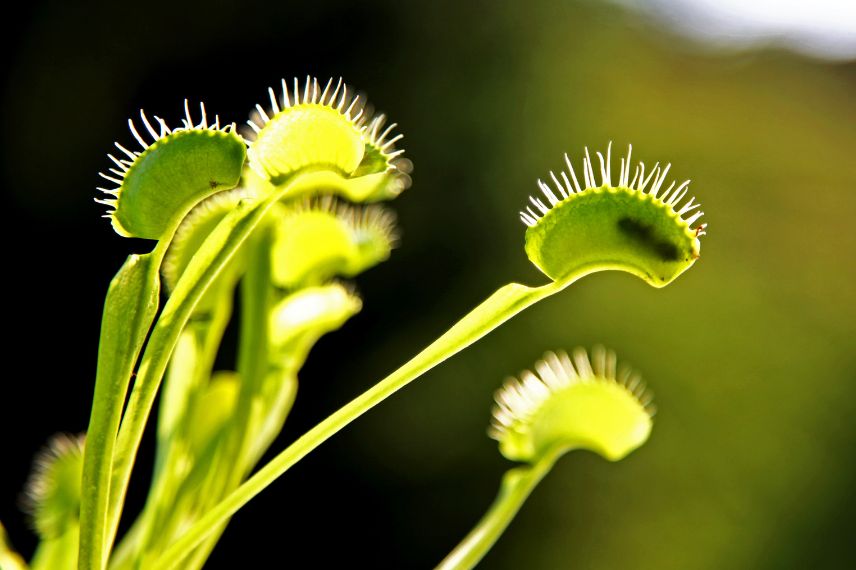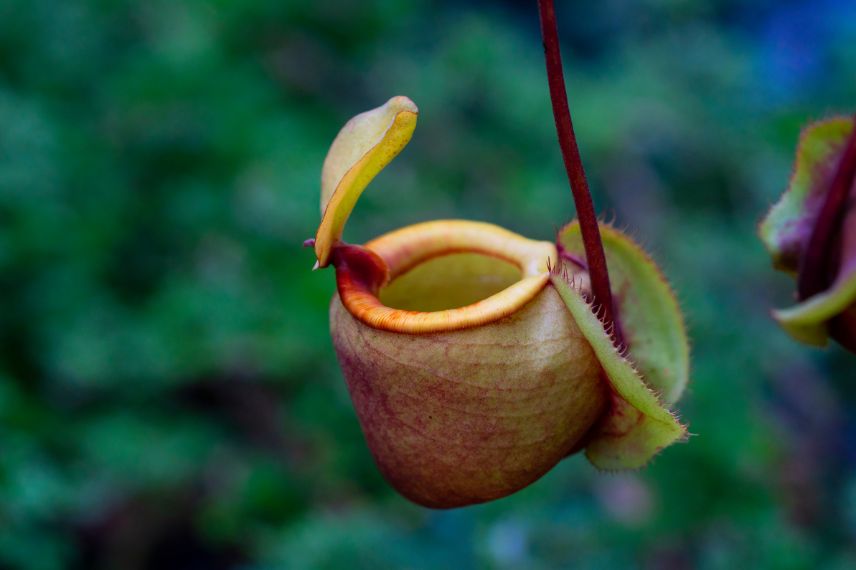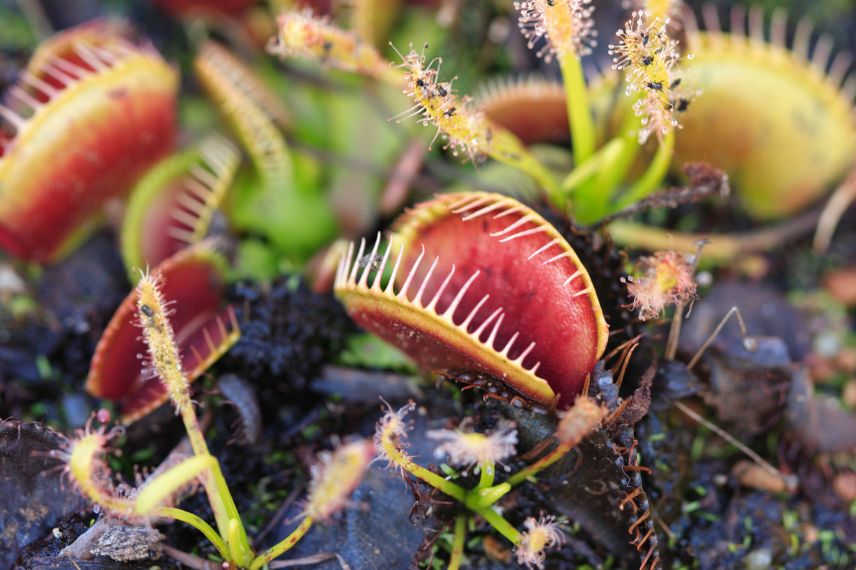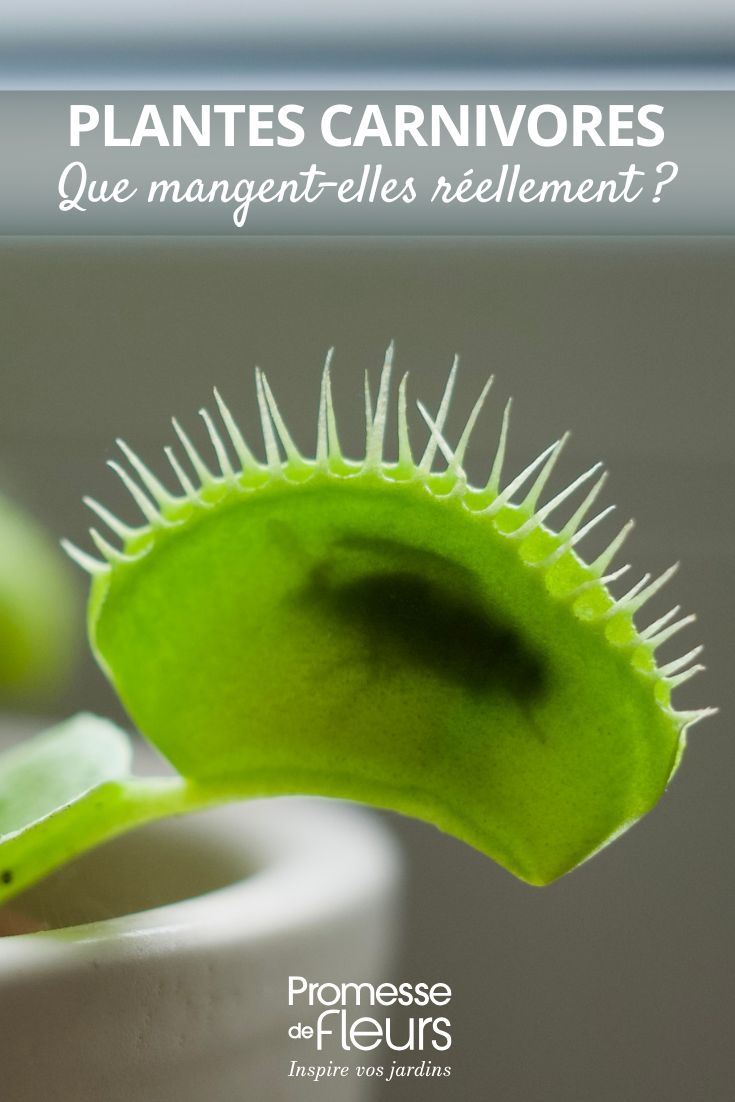
What do carnivorous plants really eat?
Traps, prey and digestion: the carnivorous side of plants
Contents
When we think of a plant, we often imagine something peaceful, motionless, content with sunshine, water and a bit of soil. But some plants completely shatter this image… They are the carnivorous plants! With their strange and sometimes spectacular traps, they intrigue as much as they fascinate. But fundamentally, what do they really eat? Do they feed solely on insects? Can we truly speak of “carnivory” in a plant? And above all, can (or should) we feed them?
Discover in this article their remarkably unique diet, separate fact from fiction, and learn why these plants are far more than mere botanical curiosities.
The diet of carnivorous plants: myth and reality
Favourite prey of carnivorous plants: who gets caught?
Carnivorous plants aren’t fussy… but they do have a specific menu, often dictated by the size and type of trap they use. Generally, they target small prey that’s easy to catch and digest.
The most common prey of carnivorous plants:
-
Flying insects: flies, mosquitoes, midges… these are the preferred targets of Venus Flytraps and Sarracenia.
-
Creeping insects: ants, beetles, stink bugs… often caught by Sundews thanks to their sticky leaves.
-
Spiders and other small arthropods: many traps are versatile enough to catch these too.
And sometimes, larger prey…
Some large Nepenthes (tropical pitcher plants) have been observed capturing frogs, lizards or even small rodents! But this is very rare, and doesn’t represent their main diet. These cases mainly occur in very humid tropical environments where prey accidentally falls into the pitcher.
So no, the Venus Flytrap won’t try to eat your kitten or your finger. Carnivorous plants are much better suited to small prey… and they never actively hunt.

Flies are part of the carnivorous plant’s diet
How do carnivorous plants digest their prey?
Once the prey is captured, the plant doesn’t stop there: it must digest to extract nutrients. And here, each species has its own technique, often as astonishing as the trap itself!
Digestive enzymes: the homemade method
Plants like the Venus Flytrap (Dionaea muscipula) or Sundews secrete their own enzymes to “break down” prey into absorbable pieces. Much like a vegetable stomach, except everything happens on the leaf’s surface or inside the trap.
Bacterial allies: the collaborative method
Other plants, like Nepenthes or Sarracenia, also rely on microorganisms present in their traps (often filled with liquid) to help decompose their victims. It’s a sort of delegated digestion, a bit slower but effective.
What’s incredible is that these plants have developed hunting strategies without nerves or muscles. Everything relies on pressure, capillary action, and tiny cellular movements. High technology… 100% natural!
Types of traps: formidable strategies
Carnivorous plants have devised traps as varied as they are ingenious, each adapted to a specific environment or prey. Watching a carnivorous plant hunt is like watching a live documentary.
- Snap traps
The Venus Flytrap is the most iconic example. Its two lobes snap shut quickly when an insect touches at least two sensitive hairs within 30 seconds. This is a safety mechanism to avoid false triggers (like a water droplet or a leaf). Once closed, the plant secretes digestive enzymes for several days.
- Sticky traps
Sundews are covered in tiny sticky hairs that glisten like dew. As soon as an insect gets stuck, the tentacles slowly curl to envelop it. It’s a slow but effective trap, like a sticky vegetable embrace.
- Pitfall traps
Nepenthes and Sarracenia produce slippery tube-shaped leaves. Insects are lured by nectar at the top, lose their footing, and fall into an enzyme-filled liquid where they slowly drown. Some pitchers even have lids to prevent dilution by rain!
- Suction traps
Aquatic Bladderworts (Utricularia) use underwater traps that suck in micro-prey in less than a millisecond. It’s the fastest trap in the vegetable kingdom!
- Lobster-pot traps
More rare, Genlisea lure microorganisms into an underground spiral. There’s no turning back: prey get lost in a one-way tunnel.

Pitfall traps of some carnivorous plants
What carnivorous plants don't eat (and what you should never feed them)
When you first encounter a carnivorous plant, it’s tempting to want to feed it yourself… but beware, they don’t eat just anything! And a “good intention” can sometimes do more harm than good.
What you should never feed carnivorous plants:
-
Pieces of meat, ham, fish, cheese… basically anything from the fridge. These foods are far too rich for them, likely to rot in the trap and kill the plant.
-
Pet food, kibble, etc.: same problem, too heavy and unsuitable.
-
Dead insects that are too dry: if you want to feed them manually (which isn’t necessary outdoors), the prey needs to be somewhat fresh to trigger digestion.
And above all: no force-feeding!
Carnivorous plants don’t need to be fed regularly. Too much prey can exhaust the plant, or even cause it to rot, especially indoors where humidity is lower. The ideal solution? Let them hunt on their own, as in nature.
A useful reminder: a trap (like that of a Venus flytrap) only closes a limited number of times. Each closure costs the plant energy. So, avoid triggering them just to “see how it works”, it’s a real boost for their health.
The actual nutritional needs of carnivorous plants
One might think that carnivorous plants need a lot of prey to survive, but in reality, their needs are quite modest. What they lack in the soil are mainly certain essential nutrients, particularly:
Nitrogen, the king of growth
This is the main element they seek from their prey. Nitrogen is essential for producing proteins, chlorophyll, and enzymes. The soils where carnivorous plants grow are often nitrogen-poor, hence their need to trap insects to compensate.
Phosphorus, potassium & co
These nutrients aid in flowering, root formation, and the overall healthy functioning of the plant. Prey provides them with a welcome little cocktail, even though they continue to produce their energy via photosynthesis like all other plants.
Water, light, and clean air: the real foundation of their health
The real secret to a thriving carnivorous plant isn’t about “stuffing” it, but rather providing it with a suitable environment:
-
Plenty of natural light (or horticultural lamp indoors)
-
Rainwater, osmosis-treated, or demineralised water, never tap water (too many minerals)
-
Humid and clean air, especially for tropical Nepenthes and Drosera
Basically, a well-established carnivorous plant will almost never need an extra item on the menu.

Let carnivorous plants manage their own diet, but give them good growing conditions
- Subscribe!
- Contents
































Comments